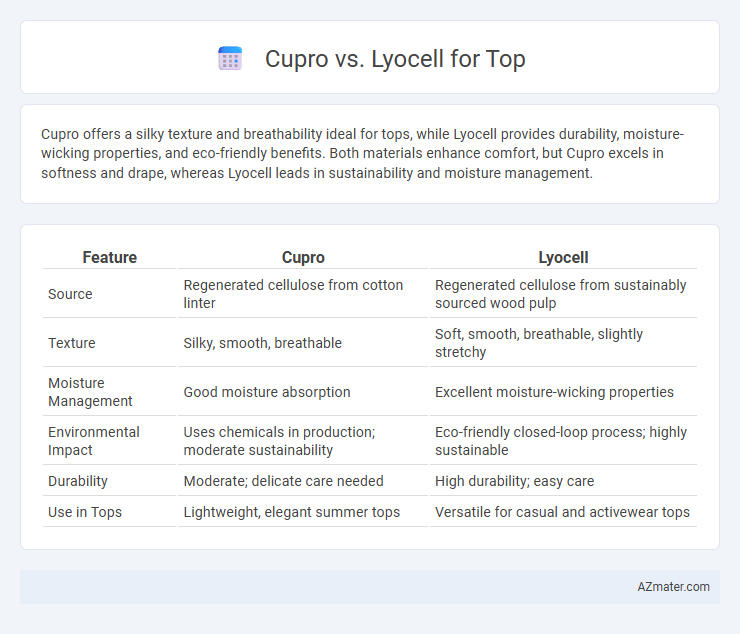Cupro offers a silky texture and breathability ideal for tops, while Lyocell provides durability, moisture-wicking properties, and eco-friendly benefits. Both materials enhance comfort, but Cupro excels in softness and drape, whereas Lyocell leads in sustainability and moisture management.
Table of Comparison
| Feature | Cupro | Lyocell |
|---|---|---|
| Source | Regenerated cellulose from cotton linter | Regenerated cellulose from sustainably sourced wood pulp |
| Texture | Silky, smooth, breathable | Soft, smooth, breathable, slightly stretchy |
| Moisture Management | Good moisture absorption | Excellent moisture-wicking properties |
| Environmental Impact | Uses chemicals in production; moderate sustainability | Eco-friendly closed-loop process; highly sustainable |
| Durability | Moderate; delicate care needed | High durability; easy care |
| Use in Tops | Lightweight, elegant summer tops | Versatile for casual and activewear tops |
Introduction to Cupro and Lyocell
Cupro, a regenerated cellulose fiber derived from cotton linter, offers a silky texture and excellent breathability, making it ideal for lightweight tops. Lyocell, produced from sustainably harvested wood pulp through a closed-loop process, boasts high moisture absorption and eco-friendly properties, perfect for comfortable, breathable tops. Both fibers combine softness and durability, with Cupro excelling in smoothness and Lyocell standing out for environmental sustainability.
What is Cupro?
Cupro is a regenerated cellulose fiber derived from cotton linter, known for its silky texture and breathability, making it ideal for lightweight tops. Unlike Lyocell, which comes from sustainably sourced wood pulp, Cupro offers a unique softness and moisture-wicking ability, providing comfort and a luxurious feel in apparel. Its fine fibers contribute to excellent drape and durability, enhancing the overall wearability of tops crafted from this material.
What is Lyocell?
Lyocell is a sustainable fabric made from wood pulp, primarily sourced from eucalyptus, oak, and birch trees, known for its softness, breathability, and moisture-wicking properties. Unlike Cupro, which is regenerated cellulose from cotton linter, Lyocell is produced through a closed-loop process that recycles water and solvents, minimizing environmental impact. This fabric is ideal for tops due to its durability, smooth texture, and eco-friendly production methods, making it a popular choice for sustainable fashion.
Cupro vs Lyocell: Environmental Impact
Cupro is a regenerated cellulose fiber made from cotton linter waste, which utilizes agricultural by-products and reduces landfill waste, but it requires toxic chemicals like copper ammonia in its production process. Lyocell is produced from sustainably sourced wood pulp through a closed-loop process that recycles over 99% of the solvents, resulting in a significantly lower environmental footprint. Compared to Cupro, Lyocell demonstrates superior water efficiency, lower energy consumption, and minimal chemical pollution, making it a more eco-friendly choice for sustainable fashion tops.
Comparison of Cupro and Lyocell Production Processes
Cupro production involves dissolving cotton linter cellulose in copper-ammonium solution, followed by regeneration into fibers through a wet-spinning method, which requires chemical-intensive processing and significant water use. Lyocell is produced by dissolving wood pulp in a non-toxic organic solvent called N-methylmorpholine N-oxide (NMMO), utilizing a closed-loop system that recycles over 99% of the chemicals and water, promoting sustainability. The environmental impact of Lyocell production is considerably lower than Cupro's due to its efficient solvent recovery and reduced chemical waste.
Cupro vs Lyocell: Feel and Comfort
Cupro offers a silky, smooth texture that feels cool and breathable against the skin, making it ideal for sensitive skin and hot weather. Lyocell is soft and drapes well with excellent moisture-wicking properties, providing comfort by keeping the wearer dry. Both fibers are eco-friendly, but Cupro's luxurious softness contrasts with Lyocell's slightly more textured, natural fabric feel.
Durability and Maintenance: Cupro vs Lyocell
Cupro offers moderate durability, maintaining its structure well with gentle handling but requiring delicate care to avoid damage from heat and abrasion. Lyocell features high durability due to its strong fibers and resistance to shrinking or wrinkling, making it easier to maintain through regular washing and minimal special treatment. Both fabrics benefit from air drying and low-temperature ironing, but Lyocell's resilience ensures longer-lasting performance in everyday wear.
Style and Appearance for Tops
Cupro fabric offers a silky, lustrous finish that enhances the drape and elegance of tops, creating a sophisticated and polished look. Lyocell features a smooth, matte surface with excellent breathability, lending a natural and refined appearance that suits casual and chic styles. Both materials provide a luxurious feel, but Cupro excels in sheen and fluidity while Lyocell stands out for its subtle texture and lightweight structure.
Cupro vs Lyocell Pricing
Cupro fabrics generally command a higher price than Lyocell due to their complex production process and the use of regenerated cellulose from cotton linter. Lyocell, derived from sustainably harvested wood pulp, offers a cost-effective alternative with efficient closed-loop production minimizing waste and lowering expenses. Brands often choose Lyocell for affordable, eco-friendly tops, while Cupro targets the luxury market with premium pricing reflecting its silky texture and durability.
Which Fabric is Best for Tops: Cupro or Lyocell?
Cupro offers a silky, breathable texture with excellent drape, ideal for luxurious tops that require a smooth finish and moisture-wicking properties. Lyocell, derived from sustainable wood pulp, provides durability, softness, and excellent moisture management, making it perfect for everyday wear and active tops. For tops, Lyocell often stands out due to its eco-friendly production and superior strength, while Cupro excels in elegant, lightweight garments demanding a refined sheen.

Infographic: Cupro vs Lyocell for Top
 azmater.com
azmater.com